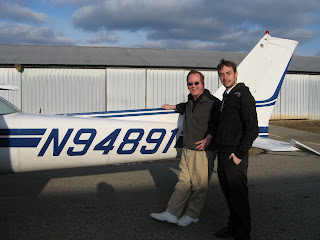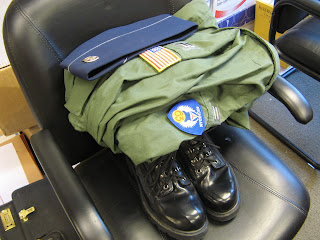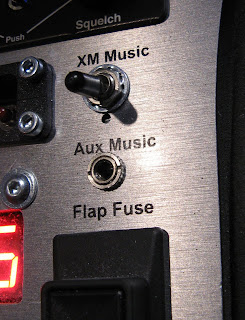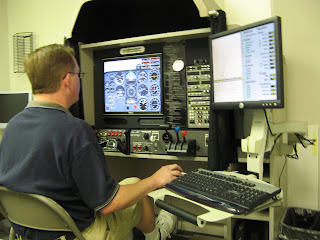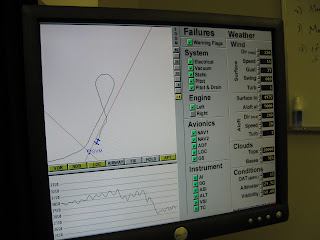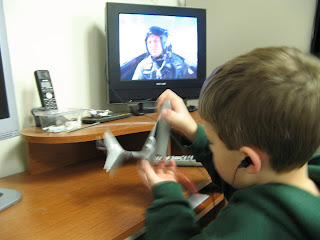Here’s the full text of the comment that I intend to submit to the Transportation Security Administration (the TSA) in response to its Notice of Proposed Rulemaking (NPRM) that would implement the so-called Large Aircraft Security Program (LASP).
.
But the TSA has entirely missed the point and proposed a rule that will likely make it difficult or impossible to operate many
with max gross takeoff weights of more than 12,500 pounds.
If you share my views and would like to be noted by name in the comment as a listener or fan of Airspeed who concurs with the comment, please leave a comment at the end of this entry or send me an e-mail at
. Please give your full name. US citizens only, please, but expressions of support by non-US citizens are always welcome.
If I get enough named supporters so it looks like a real groundswell of support, I’ll include the list in the spot at the bottom. If I don’t get a big response, I’ll probably leave the list of supporters off. Either way, your expression of support will be appreciated.
Note that I am very upset over the proposed rule and the text and tone of my comment reflects this as best I know how.
.
AOPA, NBAA, and others will certainly give intelligent, objective, and well-reasoned comments to the NPRM and I look forward to reading them. But the TSA needs to know that some of us, in addition to being intelligent, objective, and reasonable, are rightly indignant and aren’t about to let the process happen without giving full vent to our feelings.
Here at Airspeed, I’m executive producer, chief pilot, and janitor. It’s a lot of work, but it also means that I get to say what’s on my mind without holding back. So here’s what’s on my mind.
DEPARTMENT OF HOMELAND SECURITY
Transportation Security Administration
In re:
Large Aircraft Security Program, Other Aircraft Operator Security Program, and Airport Operator Security Program
Transportation Security Administration
49 CFR Parts 1515, 1520, 1522, 1540, 1542, 1544, and 1550
Docket No. TSA-2008-0021
RIN 1652-AA53
Comment of Stephen L. Tupper
Ladies and Gentlemen:
I fear that the TSA and the DHS, have yet again sorely mistaken overbearing and paranoid measures for policies that will provide safety or security to the nation’s persons, property, or treasure and I am compelled to petition you to turn away from this path.
I comment in my own individual capacity and my comments should not be taken as representing any organization or enterprise with which I work or of which I am a member. Thankfully, this affords me the luxury of pulling no punches and giving you full benefit of my feelings on this matter. I’m not an alphabet organization or other group that needs to speak politely and compromise in order to fight another day. I can say what I wish. And I shall.
I am a private pilot (airplane single-engine and multi-engine land, instrument airplane). I also hold a second-in command type rating in the Douglas DC-3. Further, I independently produce Airspeed, the popular aviation and aerospace podcast (www.airspeedonline.com).
1. Why I Care (Among Other Reasons)
In May of 2008, I was privileged to live a part of uniquely American aviation history. Along with three other students and a talented instructor, I took to the skies surrounding Griffin, Georgia in a Douglas DC-3. Over the course of three days, 2.8 logged hours, 14 takeoffs, and 13 landings, I became type-rated to fly the DC-3 as second-in-command.
As I flew the ‘three, something happened that I’ve never seen before or since. After the first trip or two around the pattern at whatever airport we used, vehicles began to stop along the side of the road at the approach end of the runway. On short final, I could see people standing by the side of the road looking up at this ghost from another age. I know that some of them must have been running late for appointments or had other things to do, but this sight made them pull over and stand in the midst of strangers looking up to see this aircraft.
When is the last time you experienced an example of Americana that caused people to pull over to the side of the road and stand there for half an hour or more, enchanted?
The present NPRM would bother me deeply even if I hadn’t had this experience with the ‘three. But the ‘three, with a maximum gross takeoff weight of around 25,500 pounds, is squarely within the sights of an unjust and unwarranted rule that threatens to take the ‘three and hundreds like her out of the skies.
I rise to speak for the DC-3. And for general and commercial aviation operators and airports that can ill afford the destructive effects of the proposed rule.
2. Costs and Operational Burden
Many aircraft stir our hearts. They call us to the airport to see them flown and, if we work impossibly hard and are extraordinarily lucky, fly them ourselves. But it is already ruinously expensive to maintain and fly many of the aircraft that we most love.
During my DC-3 training, the instructor pulled a few of us aside to make a point about why you manage the power carefully and don’t ride the brakes on a DC-3. He showed us a donut-shaped bladder about two feet in diameter. “This is a brake actuator for the ‘three. It expands under pressure and presses the brake pads against the braking surface. It costs about $2,000. When you can buy one. At the moment, you can’t buy one. Anywhere. We lose one of these and we’re done until one of these becomes available again.”
And that’s just a small indicator of the challenges that operators of such aircraft already face. The fact of the matter is that the DC-3 training center, the Commemorative Air Force, the Yankee Air Museum, and other organizations that operate classic aircraft already daily face heart-rending choices about what to save and how to save it.
This camel is already loaded down beyond reason by the economy, parts availability, certifying pilots and keeping them current, maintaining facilities, and otherwise preserving these vital parts of American heritage. To add yet another straw to the camel’s back will surely break it. It’s already breaking. And yet the TSA proposes to drop a load of lumber onto the load.
With the LASP, an operator of such aircraft would face substantial additional cash costs and administrative burdens. Training operations like the DC-3 school would have to screen every student as both a crew member and as a passenger through third-party screening providers that are as yet ill-defined, ill-regulated, and apparently able to charge whatever they can in this new TSA-created oligopolistic service market.
And others would at least have to screen passengers. When a ride in a B-17 for a World War II veteran and his children already runs well over $450 per seat and is prohibitive for most, an additional $50, $75, or $100 each for screening will thin even more the population willing to have such an experience and will leave aircraft on the ground for want of financial viable operations.
Operators would need to implement a comprehensive security program and have it approved by the TSA under uncertain and undefined criteria. And the operator would then be subject to audit by yet other private contractors in a second layer of largely unsupervised, uncontrolled delegation of government authority that could shut down such an operator without anything approaching due process.
Operators would additionally need to meet yet more recordkeeping, retention, and privacy requirements, adding to what is already one of the most paperwork-intensive endeavors known to man.
Additionally, operators would be prohibited from carrying any of the items on the TSA’s list of prohibited items (
http://www.tsa.gov/travelers/airtravel/prohibited/permitted-prohibited-items.shtm) in an accessible place. This is unreasonably inconvenient at best and potentially dangerous at worst. As a general aviation pilot, I carry a Swiss army knife and a 4” lockblade in my flight bag within reach at all times in case I need to cut a seatbelt or otherwise free myself of a passenger from the airplane under emergency circumstances. Further, if flying over remote areas, at night or otherwise, I would be inclined to carry flares or other appropriate signaling devices. These are safety issues. If I can’t reach important safety equipment when it’s needed (including potentially when I or another person is immobilized in wreckage in a remote area with hours or days before rescue), I endanger myself and my passengers.
And this isn’t just about pointy or flammable things. This is about tools, spare parts, and other cargo that is absolutely essential if one is planning to take a DC-3 or other classic large aircraft cross-country. Lots of tools. And yellow-tagged parts. I suppose that one could bonk a person over the head with any of them. But is it really more responsible to leave behind vital aircraft support supplies?
And what of cargo transport of just-in-time parts or other commercial items? Any one of which might be pointy, sharp, or otherwise potentially injurious. Are we to seal off the entire cargo area when carrying such materials? And is it safe to make the cargo area inaccessible in flight so that flight crew cannot check whether it has shifted and whether it remains secure?
In addition to the safety issues, there’s a substantial cost issue here. Many of the aircraft covered by the LASP do not have compartments in which to secure such items. The designers (who in many cases, participated in opening the frontiers of aviation in the first place) saw no need for them. In at least some cases, one would require a TSO, STC, or other regulatory clearance to alter the structure of the aircraft to create and install such compartmentalization. In those and other cases, the cost to retrofit aircraft to perform their current missions would be prohibitive or even exceed the value of the aircraft themselves. Either way, you ground an otherwise perfectly airworthy aircraft and make it unavailable to the people who depend on its services and to the people who earn their livings operating and maintaining those aircraft.
Further, if such an operator operates at an affected general aviation airport, the airport faces its own additional burden of complying with nearly airline-style security programs. General aviation airports already face staggering burdens. Neighborhoods encroach on them. NIMBYs fiercely fight much-needed expansion. The present downturn in the economy has already had a substantial effect on numbers of operations, patronage at FBOs, airframe and powerplant maintenance business, and other factors. Adding a security program at the more than 300 additional airports is yet another burden that most airport operators can ill afford now or in the near to intermediate future.
In fact, the LASP could cause vital aircraft to have to cease operating at certain smaller fields and move to larger airports with more robust security already in place. This makes the aircraft unavailable to smaller communities and also massively increases the costs to hangar and maintain the aircraft at a larger airport (See
http://www.aero-news.net/index.cfm?ContentBlockID=230cd2f3-ac75-40f2-b283-f5ee2541d81b).
3. Affected Aircraft(a) Historic Aircraft
The public, and much of the pilot population, probably does not understand the scope of the LASP or its effect on actual aircraft that they know and love.
All of the following aircraft have max gross takeoff weights of greater than 12,500 pounds but less than 100,000 pounds and are presently held and operated by the Commemorative Air Force, the Yankee Air Museum, or any number of other preservation organizations and commercial operators throughout the United States.
Aircraft and Max Takeoff Weight (Varies within Type)Boeing B-17 Flying Fortress - 65,500
Chance Vought F4U Corsair - 14,449
Consolidated B-24 Liberator - 65,000
Curtiss C-46 Commando - 48,000
Curtiss SB2C Helldiver - 16,800
Douglas A-26 Invader - 35,000
Douglas DC-3/C-47 Skytrain/Dakota - 31,000
Douglas B-23 Dragon - 32,400
Fairchild C-119 Flying Boxcar - 64,000
Fairchild C-82 Packet - 54,000
Ford Tri-Motor - 13,500
Grumman AF-2S Guardian - 25,500
Grumman Avenger - 17,893
Grumman F6F Hellcat - 15,415
Grumman F8F Bearcat - 12,947
Grumman HU-16 Albatross - 33,000
Grumman G-73 Mallard - 12,750
Junkers Ju 52 - 24,200
Lockheed C-60 Hudson - 18,500
Lockheed L-18 Lodestar - 17,500
Lockheed PV-2 Harpoon - 31,077
Lockheed T-33 - 15,100
North American B-25 Mitchell - 41,800
North American P-82 Twin Mustang - 25,591
PBY-6A Catalina - 64,450
Republic P-47 Thunderbolt - 17,500
And, if you lower the threshold for the proposed rule, to 10,000 pounds, you will bring into the sights of the rule, among others, the Douglas SBD Dauntless and the North American P-51 Mustang.
You’ll note that I’ve largely neglected the TSA’s disingenuously-phrased specific requests for comments. But I’ll be happy to directly address one, namely the weight cutoff for the LASP.
If I were the TSA, I’d avoid the neighborhood of 12,100 pounds. There’s a hornet’s nest of public outcry waiting for you at 12,100 pounds. About 1,375 of those pounds consist of a Merlin engine. That engine and the rest of the airplane constitute a large part of the reason that you hold the jobs that you do and that you have promulgated the NPRM in English instead of German or Japanese.
Be very careful. You might get away with decimating other grand dames of the skies, but every redneck, suit, line worker, banker, lumberjack, lawyer, cop, fireman, landscaper, fast-food cashier, and child able to stand recognizes the mighty P-51 Mustang. Not that aviation would fail to miss the other aircraft that the TSA would so cavalierly tear from the sky, but at least we have the P-51 Mustang still guarding the 12,100-pound boundary.
(b) Modern Aircraft
Many modern aircraft also fall within the scope of the NPRM. Included among them are such aircraft as the King Air 300 series and about 10% of business jets. If you take the weight limit down to 9,000 pounds, you ensnare the Citation CJ-1 and Pilatus PC-12. If you take it to 6,000 pounds, you encumber barons, Meridians, Senecas, and the Matrix.
Those who fly such aircraft are among the lowest-risk operators of which you could conceive. These operators know their passengers and such passengers are frequently family, friends, business associates, and employees. Must a pilot who operates his or own large aircraft conduct a background check on him- or herself? Screen his or her mother?
As I said before, it’s already ruinously expensive to operate an aircraft (and create and sustain all of the jobs associated with the support services that you buy, etc.) The requirements of the LASP will keep unnumbered people from obtaining or operating large aircraft and will cause other unnumbered present operators to fall out of the market.
I’m reminded of the recent brilliant editorial cartoon by Chip Bok (see
http://www.cartoonistgroup.com/store/add.php?iid=29017) in which a legislative committeeman informs a businessman that no bailout would be available if the supplicant has flown to the hearing on a corporate jet. The committeeman then asks why the businessman’s company is failing. To which the business man answers, “We make corporate jets.”
In this economy and under circumstances under which the TSA will gain no additional security, why must it impose such costs on such a vital industry?
I have put myself through two graduate degree programs at night and worked tirelessly for the last 20 years in the hopes of building a lucrative career. Although I love my work, you can be assured that the work itself is not adequate motivation. I work so that, among other things, I might one day have funds sufficient to afford an aircraft with a max gross takeoff weight of more than 12,500 pounds. There are many thousands of people just like me with similar motivations and we pay untold millions into the nation’s coffers each year in taxes. Why must you, by this regulation, place the brass ring that much higher with a senseless regulation?
4. CostI think that I have adequately covered the cost issues in terms of their effects on individual operators and airports. But I feel that it’s worthwhile to comment briefly on the macro cost of the LASP.
I’m absolutely shocked. I just can’t believe that the TSA would impose a program that is, by the TSA’s own admission, so costly. The Paperwork Reduction Act notice alone is appalling. Compliance will require 1 million hours per year in paper shuffling alone. Folks, as I see it, that’s 11 lives per year lost right off the bat. 11 deaths of the worst kind. 11 lifetimes spent shuffling paper. Every year. And that’s only the operators of the aircraft!
And the price tag in dollars is something like $1.1 billion over 10 years for operators and $5.5 million for airport operators over 10 years. To say nothing of the $136.6 million in taxpayer dollars that the TSA itself intends to waste in implementation
5. The Regulation Will Be Ineffective
The cost is especially massive when one considers that nearly every minute, dollar, piece of paper, and scrapped aircraft will be for naught because the regulation will not be – and can not be – effective.
I had to laugh out loud when I read the Executive Order 12866 Assessment of Benefits. According to the NPRM, “. . . TSA cannot quantify these benefits, however, TSA conducted a ‘break even’ analysis to determine what reduction of overall risk of a terror attack and resulting reduction in the expected losses for the nation due to the terror attack would be necessary in order for the expected benefits of the rule to exceed the costs.”
[1]The TSA then goes on to paint four fanciful pictures of the destruction that might be wrought by large aircraft.
It starts with $32 million for ramming a large aircraft into a rural area and proceeds to $1.73 billion for the same thing in a populated area and to $49 billion for a World-Trade-Center-style attack (complete with numbers from the office of the New York City Comptroller). And then the TSA gives free rein to the most fanciful denizens of its anxiety closet and comes up with a $1 trillion scenario in which a nuclear or biohazard event wipes out the eastern seaboard. As long as the TSA was going all-out, I was frankly disappointed that the TSA omitted Martians and large-aircraft-mounted sea bass with lasers.
I joke because I have to in order to remain sane in the face of the sheer and towering paranoia exuded by the TSA.
You are supposed to understand aircraft and other means of transportation. You are supposed to be better than this. Yet you starkly demonstrate a terrifying ignorance and lack of understanding of even the most basic nature of the risk that the country faces and instead build wild paranoid fantasies to justify imposition of these regulations.
Airplanes of the kind that are subject to the proposed rule are wholly inefficient instruments for terrorism. They require hours of training to so much as start and taxi the aircraft effectively. (Come on out and taxi a DC-3 around the airport with me. It’s like driving your house down the street from a second-floor window on an icy day.) They demand talents that require many more hours in order to take off and operate. It would be nearly impossible to obtain such training without also having spent the bare minimum of 50 hours of other flight training (and more likely 100 or more hours) in order to obtain the certificates and ratings that any training facility would require of a pilot seeking such training.
And lest you worry that an unwilling pilot might plow a DC-3 into a building, you can be assured that each of us has thought about the issue long and hard even before September 11, 2001 and we have plenty of maneuvers up our sleeves for such occasions. I’m quite sure that you would be surprised by the maneuverability of a DC-3 whose pilot’s best other option is flying it into a building. I’m sure that there are at least some of my brethren who secretly yearn for an excuse to perform such maneuvers. Suffice it to say that a weightless and inverted terrorist is usually ineffective both during and after certain maneuvers. As is one who suddenly weighs two or three times what he or she is accustomed to weighing. Sideways.
Look, even for all of my bravado here, it remains that if a terrorist is well-trained, skilled, and committed, there is absolutely nothing in the LASP that will keep that terrorist from using a large aircraft for nefarious purposes. The LASP will protect us from lazy, retiring, cowardly, or incompetent terrorists. Those unwilling to climb a fence or use a fake ID. But it’s not going to keep a dedicated and suicidal person from carrying out an attack. Heck, it wouldn’t even keep out most of the 9/11 attackers. 18 of the 19 would have passed the required crew background check with flying colors and be compliant with LASP all the way to impact.
And it completely mystifies me that the TSA continues to miss the most important point in all of this. There’s absolutely nothing you can do with an aircraft subject to the proposed rule that you can’t do cheaper, faster, and more safely (for the terrorist) with a 20-foot rental truck. Yet it is now almost 14 years since just such a truck was used to decimate the Alfred P. Murrah Federal Building in Oklahoma City and it still requires no background check, no security clearance, and no air marshal to rent just such a vehicle at any of thousands of establishments located within convenient driving distances from prominent and high-value targets around the country.
A couple of guys with a rental truck and some fertilizer, TNT, or C4 can carry more destructive power and get it closer than any large aircraft could. Yet the TSA insists on ruminating over coordinated fleets of DC-3s and Grumman Mallards converging on a downtown somewhere.
The TSA takes as an article of faith that “enhanced security” will result from LASP. The cold, hard fact is that the LASP will do absolutely nothing to enhance security. It is fatally flawed. The terrorists that we actually need fear will find it no barrier. And, in fact, the terrorists that we actually need fear are much better off heading to the truck rental place and they know it.
6. The Slippery SlopeI generally dislike any rhetoric that relies on the argument of the “slippery slope.” That if we are to do a thing to one extent, we will necessarily proceed to carry the thing to its extreme. But my objection to slippery-slope arguments is also generally confined to circumstances in which the regulator is limited by goodwill, competence, intelligence, and/or procedural checks – none of which seem to burden the TSA.
It is apparent to any literate American that the TSA is perfectly willing to regulate for the sake of regulating regardless of the cost and regardless of whether the regulation will have any real benefit.
Under both the LASP and its enabling legislation, the TSA has acted with imperial abandon. Just recently, the TSA issued a Security Directive requiring thousands of additional persons to be fingerprinted and meet other standards necessary to qualify them for airport identification badges at hundreds of commercial airports across the country, even where general aviation operators are physically separated from commercial operations and no threat or incident has occurred or is likely to occur. The SD has the force of law but is not subject to any legislative or other oversight. And we have no reason whatsoever to expect that the TSA will refrain from continuing to issue such directives at its whim.
The TSA has become a classic example of what Justice Benjamin Cardozo famously termed “delegation running riot.” See
A.L.A. Schechter Poultry Corp. v. United States, 295 U.S. 495 (1935) and
Panama Refining Co. v. Ryan, 293 U.S. 388 (1935). The TSA has undertaken unprecedented intrusions into the liberties of American persons and businesses, all apparently without any congressional direction worthy of the name. How long must we go before we again look to the jurisprudence of the Great Depression when government agencies, drunk with the power granted to them in the New Deal, finally had to be reined by the courts from their frolics, detours, and rampages?
How long must we put up with these arbitrary and manifestly ineffective unfunded mandates? Must we wait until some of the grandest aircraft ever to grace the skies have sat in boneyards too long to rekindle the fires in their round engines? How many have to fall? How many must become silent?
Ladies and gentlemen, we have had enough of watching our government flail about, dispossessing us of freedom after freedom, from ignoring the FISA courts to conducting warrantless wiretapping to eviscerating Constitutional allocations of power with executive signing statements to other bad faith in high places. All in the name of doing something – anything – to make those too lazy or complacent to understand the facts feel better. Regardless of whether it makes any sense and regardless of the consequences.
This is no matter of mere inconvenience.
Pilots are well-accustomed to operating in one of the most highly-regulated areas of endeavor in which a citizen may engage. We heartily support regulatory schemes that promote genuine safety and efficiency of operations. In fact, by pride, competence, and peer pressure, we are ourselves the nation’s best enforcers of sensible aviation policy. But we have no patience whatsoever for the ill-advised rot that is the LASP as presently proposed.
And here is what frosts my socks the most.
The general public does not understand aviation. Less than 0.2% of the American public hold pilot certificates. With the images of September 11, 2001 still high in the public’s consciousness, the average American is a sucker for any criticism of aviation and reacts with Pavlovian dependability to any suggestion that aviation is dangerous in any way.
Limiting aviation of any kind receives immediate and positive reaction from the general public. It’s low-hanging public-relations fruit. And it’s ripe for abuse by those who care more about the appearance of doing something that they do about actually doing something. The TSA is preparing to take yet another cheap shot. And it’s despicable.
The DHS’s failure to regulate rental trucks or implement any of hundreds of other more effective and less costly measures while instead going after aircraft is proof positive that the DHS and the TSA care far more about public relations points than about actually addressing the issues that each was chartered to address.
Here’s a thought experiment for you. If it were not possible to actually enhance security by regulating, would you have the guts to not regulate? Stop now and ask yourself the question. Who at the TSA has the guts to stand up and point out the elephant in the room? Who has the chutzpah to speak the truth? To refrain from regulating for regulation’s sake? Who has the nerve and the integrity to count the real cost and stand up for an unpopular and inconvenient proposition? The proposition – the demonstrable and true proposition – that the LASP will cost us large parts of our heritage, our history, our treasure, and our freedom, but will not make us one iota more secure.
Stand up, sir. Stand up, madam. I and my brothers and sisters who ply the aether of American skies in gossamer ghosts of the era of Schechter and Panama – We will meet you more than halfway. If your goal is real security and rational processes, you will have as your allies the skilled, the courageous, the bold, and the competent. The guardians of the oldest of dreams and the most precious of freedoms. The pilots of the United States of America.
But, until such a leader speaks up, we are honor-bound to oppose this unjust rule with every voice.
7. SummaryWho could have guessed that Mohamed Atta and his co-conspirators, in addition to decimating the World Trade Center towers and damaging the Pentagon, would also knock from the skies grand emissaries of the golden age of aviation? And who could have guessed that the regulators upon whom we depend would be party to it?
The LASP is nothing less than cowardice, laziness and incompetence on a monumental scale. The proposed rule is fatally flawed and cannot accomplish any of its stated goals and the TSA knows it. This nation’s heritage, its citizens, and its pilots deserve better. I, for one, insist on better.
I oppose the entire LASP as proposed in the NPRM. Please withdraw it in its entirety and don’t come back until you have a workable program that actually addresses genuinely balanced security that is worthy of the civil society that the TSA is charged with protecting.
Respectfully submitted,
Stephen L. Tupper
Date: February 27, 2009
I have promulgated this comment by reading it in an episode of Airspeed. At the conclusion of that episode, I invited listeners to concur with this comment by e-mailing expressions of concurrence to me. The following persons sent such concurrence. Each such individual is concurring in his or her own individual capacity and no such concurrence should be taken as representing the views of any organization with, or for, which such person works.
and, if I receive enough concurrences, I'll include them with the final comment.



